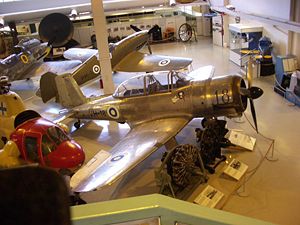Valmet Vihuri Video - Picture

|
|
Valmet Vihuri
Valmet Vihuri

Role: Trainer
Manufacturer: Valmet
First flight: February 6, 1951
Retired: 1959
Primary user: Finnish Air Force
Number built: 51
Valmet Vihuri (Finnish for Gale) was a Finnish advanced two-seat fighter trainer aircraft, serving in the Finnish Air Force between 1953 and 1959.
History
In spite of their economical problems, the aircraft manufacturer Valmet began designing a new aircraft in the beginning of the 1950s, to replace the aging FAF VL Pyrys. Martti Vainio was the chief designer of the project. Most of the planning was made by the aeronautic engineers L. Hx¤mx¤lx¤inen and T. Mx¤ntysalo in 1948-49. The Bristol Mercury was chosen as the engine, since there were no other alternatives. The Mercury was license made in Finland for the Bristol Blenheim bomber. The prototype (VH-1) made its first flight on February 6, 1951 in Tampere, piloted by captain Esko Halme. After the successful test flights, the FAF ordered 30 aircraft of the production series, called Valmet Vihuri II on February 27, 1951. In the autumn of 1954, the air force ordered a further 20 aircraft of the developed version Valmet Vihuri III. All the aircraft of the third version were handed over to the air force on January 15, 1957.
Valmet built 51 Vihuri's in three different series (I-III) in Kuorevesi and Tampere. The aircraft had the registration codes VH-1 - VH-51.
Operational use
The aircraft became the most used aircraft in FAF service by the mid-1950s. The aircraft was subject to many accidents and the press raised a lot of noise about these. The safety of the Vihuri even became a matter for the government. In May 1959, the aircraft was permanently grounded after the death of the Finnish prime minister's son in the aircraft type. Attempts were made to sell the aircraft to Tunisia without success.
After the inspection it became apparent that the type and its design was sound; most of the accidents were due to pilots' often grave flight regulations violations, and the fact all airframes were well worn by the end of the fifties. The planes were sold to scrap to Moser OY. One airframe, VH-18, survives in Central Finland Aviation Museum, and fore fuselage of another, VH-25, is being restored. The canopies of the scrapped aircraft remain today as the roof windows of the Kuusakoski metal recycling plant in Espoo.
Operators
Finland
Finnish Air Force
Specifications (Valmet Vihuri III)
Data from
General characteristics
Crew: Two
Length: 8.85 m (29 ft 0 in)
Wingspan: 10.4 m (34 ft 1 in)
Height: 3.66 m (12 ft 0 in)
Wing area: 18.86 m² (203 sq ft)
Empty weight: 2,174 kg (4,793 lb)
Max takeoff weight: 2,704 kg (5,961 lb)
Powerplant: 1x— Bristol Mercury VIII 9-cylinder air-cooled radial, 626 kW (840 hp)
Performance
Maximum speed: 444 km/h (276 mph)
Range: 665 km (413 mi)
Endurance: 2.5 hours
Service ceiling: 8,200 m (26,900 ft)
Rate of climb: 8.1 m/s (26.6 ft/s)
Armament
Guns: 2x— 7.7 mm Browning machine guns
Bombs: 4x— 25 kg bombs
This aircraft was not to be confused with the Finnish fast bomber variant of De Havilland Mosquito with DB 605 engines. A project that never materialized. In 1943 the FiAF HQ asked VL if it would be possible to build a copy of the Mosquito with DB605 engines. Two crashed British aircraft would have been requested from Germany to serve as models. The primary attraction was the wooden construction (something that the VL was familiar with). The inquiries indicated that serial production could be started sometime in 1946 as there were other aircrafts on queue and there were difficulties in getting just about everything needed to produce a new aircraft. The new aircraft was also to be named "Vihuri".
Preserved aircraft
The Central Finland Aviation museum is displaying the VH-18, which is the only preserved Vihuri. It gathered 802 flying hours, after which the aircraft served as an educational machine at the Air Force Academy in Kauhava.
Source
Kalevi Keskinen, Kari Stenman, Klaus Niska: Suomen ilmavoimien historia 14 - Suomalaiset hx¤vittx¤jx¤t, AR-Kustannus ky, 1990. ISBN 951-95821-0-X
Valmet Vihuri Pictures
More aircraft.
Source: WikiPedia